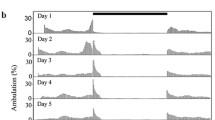Abstract
Fish schools behave like a single organism, and this offers considerable survival advantages. In our simulations, a fish school is well organized, without a leader, and behaves like a single creature depending solely on the interactions among individuals. This kind of system can be said to be typical of “complex systems.” In this article, it is shown that fractal evaluation is useful to understand the features of fish school movements. We make clear the validity of fractal analyses to quantify fish school movements through evaluations of simulated fish school movements andsardine movements. These fractal analyses show that we need two different fractal dimensions (D 1,D 2) to understand the features of fish school movements:D 1 corresponds to thesmaller coarsening levels, andD 2 corresponds to thelarge coarsening levels. The linear analyses in log-log space give an excellent fit with both the simulated movements and the sardine school movements. In approaching complex systems or complex behaviors, fractal analyses have attracted wide attention in mathematics, physical sciences, and information science. The fractal evaluations here convince us that we are coming close to understanding the structure of complex movements of animals.
Similar content being viewed by others
References
West BJ (1990) Fractal physiology and chaos in medicine. World Scientific, Singapore
Aoki I (1982) A simulation study on the schooling mechanism in fish. Bull Jpn Soc Sci Fish 48:1081–1088
Huth A, Wissel C (1992) The simulation of the movement of fish schools. J Theor Biol 156:365–385
Shinchi T, Nishimura H, Kitazoe T, et al. (2000) Quantitative analyses and fractal structures of fish school movements. In: Sugisaka M (ed) Proceedings of the International Symposium on Artificial Life and Robotics (AROB5th), Beppu, Oita, Japan, January 26–28, 2000, p 153–156
Shaw E (1970) Schooling in fishes: critique and review. In: Arson L (ed) Development and evolution of behaviour. p 452–480
Reuter H, Breckling B (1994) Self-organization of fish schools: an object-oriented model. Ecol Model 75/76:147–159
Aoki I (1980) An analysis of the schooling behavior of fish: internal organization and communication process. Bull Ocean Res Inst Univ Tokyo 12:1–65
Nishimura H, Shinchi T (1995) Fractal analysis of one-dimensional cellular automata as time-series vectors (in Japanese). Inf Process Soc Jpn Tran 36:787–796
Higuchi T (1988) Approach to an irregular times series on the basis of the fractal theory. Pysica D 31:277–283
Author information
Authors and Affiliations
Corresponding author
About this article
Cite this article
Shinchi, T., Kitazoe, T., Nishimura, H. et al. Fractal evaluations of fish school movements in simulations and real observations. Artif Life Robotics 6, 36–43 (2002). https://doi.org/10.1007/BF02481207
Received:
Accepted:
Issue Date:
DOI: https://doi.org/10.1007/BF02481207




